Influence of Organic and Mineral Fertilizers on Soil Organic Carbon and Crop Productivity under Different Tillage Systems: A Meta-Analysis
Abstract
:1. Introduction
2. Materials and Methods
2.1. Data Collection
2.2. Study Summary and Characteristics
2.3. Data Analysis
3. Results and Discussion
3.1. Soil Organic Carbon
3.2. Climate Conditions
3.3. Soil Properties
3.4. Crop Categories
3.5. Water Managements
4. Conclusions
- Climate conditions have more influence on crop yield when depending on organic sources alone, than combining both organic and inorganic fertilizers, both in comparison with inorganic sources alone.
- Crop yields of O alone compared with M were more affected by climate and tillage system in humid conditions.
- Application of organic nutrient sources alone (O) under an RT system could produce higher grains than the M fertilizers for legume crops.
- Combining both inorganic and organic fertilizers (MO) under an RT system could produce higher grains for cereal crops.
- Adopting MO fertilizers under RT practice added significant benefits in sandy soils.
Author Contributions
Funding
Institutional Review Board Statement
Informed Consent Statement
Conflicts of Interest
References
- Khush, G.S. Green revolution: Preparing for the 21st century. Genome 1999, 42, 646–655. [Google Scholar] [CrossRef] [PubMed]
- Rohne Till, E. A green revolution in sub-Saharan Africa? The transformation of Ethiopia’s agricultural sector. J. Int. Dev. 2021, 33, 277–315. [Google Scholar] [CrossRef]
- Martini, E.; Buyer, J.S.; Bryant, D.C.; Hartz, T.K.; Denison, R.F. Yield increases during the organic transition: Improving soil quality or increasing experience? Field Crop. Res. 2004, 86, 255–266. [Google Scholar] [CrossRef]
- Dadi, D.; Daba, G.; Beyene, A.; Luis, P.; Van der Bruggen, B. Composting and co-composting of coffee husk and pulp with source-separated municipal solid waste: A breakthrough in valorization of coffee waste. Int. J. Recycl. Org. Waste Agric. 2019, 8, 263–277. [Google Scholar] [CrossRef] [Green Version]
- Jones, C.; Jacobsen, J. Nutrient Management Module No.2: Plan Nutrition and Soil Fertility. Nutr. Manag. 2001, 2, 1–11. [Google Scholar]
- Willer, H.; Trávnícek, J.; Meier, C.; Schlatter, B. The World of Organic Agriculture—Statistics & Emerging Trends 2021; International Federation of Organic Agriculture Movements & Research Institute of Organic Agriculture: Bonn, Germany, 2021. [Google Scholar]
- Timsina, J. Can organic sources of nutrients increase crop yields to meet global food demand? Agronomy 2018, 8, 214. [Google Scholar] [CrossRef] [Green Version]
- Marinari, S.; Radicetti, E.; Petroselli, V.; Allam, M.; Mancinelli, R. Microbial Indices to Assess Soil Health under Different Tillage and Fertilization in Potato (Solanum tuberosum L.) Crop. Agriculture 2022, 12, 415. [Google Scholar] [CrossRef]
- Van den Putte, A.; Govers, G.; Diels, J.; Gillijns, K.; Demuzere, M. Assessing the effect of soil tillage on crop growth: A meta-regression analysis on European crop yields under conservation agriculture. Eur. J. Agron. 2010, 33, 231–241. [Google Scholar] [CrossRef]
- Tebrügge, F.; Düring, R.-A.; Du, R.; Tebru, F. Reducing tillage intensity—A review of results from a long-term study in Germany. Soil Tillage Res. 1999, 53, 15–28. [Google Scholar] [CrossRef]
- Friedrich, T.; Derpsch, R.; Kassam, A. Overview of the global spread of Conservation Agriculture. Field Actions Sci. Rep. 2012, 6, 1–7. [Google Scholar]
- 8WCCA—8th World Congress on Conservation Agriculture, Bern, Switzerland, 21–23 June 2021. Available online: https://8wcca.org (accessed on 14 February 2022).
- Mancinelli, R.; Marinari, S.; Allam, M.; Radicetti, E. Potential Role of Fertilizer Sources and Soil Tillage Practices to Mitigate Soil CO2 Emissions in Mediterranean Potato Production Systems. Sustainability 2020, 12, 8543. [Google Scholar] [CrossRef]
- Singh, B. Are Nitrogen Fertilizers Deleterious to Soil Health? Agronomy 2018, 8, 48. [Google Scholar] [CrossRef] [Green Version]
- Chen, J.; Zhu, R.; Zhang, Q.; Kong, X.; Sun, D. Reduced-tillage management enhances soil properties and crop yields in a alfalfa-corn rotation: Case study of the Songnen Plain, China. Sci. Rep. 2019, 9, 17064. [Google Scholar] [CrossRef] [PubMed]
- Amoah-Antwi, C.; Kwiatkowska-Malina, J.; Thornton, S.F.; Fenton, O.; Malina, G.; Szara, E. Restoration of soil quality using biochar and brown coal waste: A review. Sci. Total Environ. 2020, 722, 137852. [Google Scholar] [CrossRef]
- Busari, M.A.; Kukal, S.S.; Kaur, A.; Bhatt, R.; Dulazi, A.A. Conservation tillage impacts on soil, crop and the environment. Int. Soil Water Conserv. Res. 2015, 3, 119–129. [Google Scholar] [CrossRef] [Green Version]
- Palm, C.; Blanco-Canqui, H.; DeClerck, F.; Gatere, L.; Grace, P. Conservation agriculture and ecosystem services: An overview. Agric. Ecosyst. Environ. 2014, 187, 87–105. [Google Scholar] [CrossRef] [Green Version]
- Tscharntke, T.; Grass, I.; Wanger, T.C.; Westphal, C.; Batáry, P. Beyond organic farming—Harnessing biodiversity-friendly landscapes. Trends Ecol. Evol. 2021, 36, 919–930. [Google Scholar] [CrossRef]
- Kumar, M.; Singh, V.; Nikam Kumari, K.; Kumar, S.; Nandan, R.; Abraham, T. Effect of Conventional and Minimum Tillage, combine use of organic manure and synthetic based fertilizers with foliar spray of zinc sulphate for sustaining wheat productivity, quality and status of soil fertility. Preprints 2020, 2020050096. [Google Scholar] [CrossRef]
- Shumba, A.; Dunjana, N.; Nyamasoka, B.; Nyamugafata, P.; Madyiwa, S.; Nyamangara, J. Maize (Zea mays) yield and its relationship to soil properties under integrated fertility, mulch and tillage management in urban agriculture. S. Afr. J. Plant Soil 2020, 37, 120–129. [Google Scholar] [CrossRef]
- Pradhan, S.N.; Ghosh, A.K.; Nema, A.K.; Ram, S.; Pal, Y. Changes in soil phosphorus forms in a long-term cropping system as influenced by fertilization and tillage. Arch. Agron. Soil Sci. 2020, 67, 822–835. [Google Scholar] [CrossRef]
- Ramachandrappa, B.K.; Sankar GRMaruthi Satish, A.; Thimmegowda, M.N.; Dhanapal, G.N.; Kumar, N.I.; Shankar, M.A.; Rao CHSrinivasa, M.P.K. Efficient tillage and nitrogen practices for improving monetary returns and yield of finger millet and pigeonpea in semi-arid Alfisols. Ind. J. Soil Cons. 2017, 45, 157–167. [Google Scholar]
- Siebou, P.; Idriss, S.; Sibiri Jean-Baptiste, T.; Korodjouma, O.; Stephen, C.M.; Adama, S. Pearl Millet and Cowpea Yields as Influenced by Tillage, Soil Amendment and Cropping System in the Sahel of Burkina Faso. Int. J. Sci. 2019, 8, 56–64. [Google Scholar] [CrossRef] [Green Version]
- Somenahally, A.; DuPont, J.I.; Brady, J.; McLawrence, J.; Northup, B.; Gowda, P. Microbial communities in soil profile are more responsive to legacy effects of wheat-cover crop rotations than tillage systems. Soil Biol. Biochem. 2018, 123, 126–135. [Google Scholar] [CrossRef]
- Sheoran, P.; Sardana, V.; Singh, S.; Bhushan, B.; Bawa, S.S.; Singh, C.B. Long-term effect of tillage and nitrogen sources on the sustainability and productivity of maize (Zea mays)-wheat (Triticum aestivum) cropping system under rainfed conditions. Indian J. Agric. Sci. 2009, 79, 259–263. [Google Scholar]
- Sharma, K.L.; Chandrika, D.S.; Lal, M.; Srinivas, K.; Mandal, U.K.; Indoria, A.K.; Reddy, B.S.; Rao, C.S.; Reddy, K.S.; Osman, M.; et al. Long Term Evaluation of Reduced Tillage and Low Cost Conjunctive Nutrient Management Practices on Productivity, Sustainability, Profitability and Energy Use Efficiency in Sorghum (Sorghum bicolor (L.) Moench)-Mung Bean (Vigna radiata (L.) Wilczek) System System in Rainfed Semi-Arid Alfisol. Indian J. Dryl. Agric. Res. Dev. 2015, 30, 50–57. [Google Scholar]
- Choulwar, S.; Sankar, G.; Pendke, M.; Bhuibhar, B.; Mishra, P.; Chary, G.; Rao, C. Effect of tillage and nutrient management on productivity, soil fertility and profitability of cotton+soybean rotated with soybean + pigeonpea intercropping system under semi-arid Vertisols in India. Indian J. Soil Conserv. 2015, 43, 79–91. [Google Scholar]
- Huang, M.; Liang, T.; Wang, L.; Zhou, C. No-tillage and fertilization management on crop yields and nitrate leaching in North China Plain. Ecol. Evol. 2015, 5, 1143–1155. [Google Scholar] [CrossRef]
- Amegashie, B.K. Response of Maize Grain and Stover Yields to Tillage and Different Soil Fertility Management Practices in the Semi-Deciduous Forest Zone of Ghana. Ph.D. Thesis, Department of Crop and Soil Sciences, Faculty of Agriculture, College of Agriculture and Natural Resources, Kwame Nkrumah University of Science and Technology, Kumasi, Ghana, 2014. [Google Scholar]
- Endale, D.M.; Schomberg, H.; Jenkins, M.; Cabrera, M. Corn Production in No-Till and Conventional Tillage with Poultry Litter: A 5yr Data Carbon and Nitrogen Cycling and Budgets in Georgia Coastal Plain Agroecosystems View project Conservation Practice Effects in the SE Coastal Plain, USA View Project. 2014. Available online: https://www.academia.edu/15372128/Corn_production_in_no_till_and_conventional_tillage_with_poultry_litter_a_5_yr_data (accessed on 14 February 2022).
- Qadir Memon, S.; Amjad, N.; Safar Mirjat, M.; Quadir Mughal, A.; Ahmad Ibupoto, K.; Ahmad Kalwar, S.; Ali Mirani, A.; Azhar Saeed, M. Effect of tillage and use of organic and inorganic fertilizers on growth and yield components of maize. Pak. J. Agric. Res. 2014, 27, 41–50. [Google Scholar]
- Mohammadi, K.; Heidari, G.; Javaheri, M.; Rokhzadi, A.; Nezhad, M.T.K.; Sohrabi, Y.; Talebi, R. Fertilization affects the agronomic traits of high oleic sunflower hybrid in different tillage systems. Ind. Crops Prod. 2013, 44, 446–451. [Google Scholar] [CrossRef]
- Patil, S.L. Winter sorghum (Sorghum bicolor) productivity as influenced by tillage practices and nitrogen management in Vertisols of SAT, India. Soil Tillage Res. 2013, 126, 183–192. [Google Scholar] [CrossRef]
- Sankar, G.R.M.; Sharma, K.L.; Reddy, K.S.; Pratibha, G.; Shinde, R.; Singh, S.R.; Nema, A.K.; Singh, R.P.; Rath, B.S.; Mishra, A.; et al. Efficient tillage and nutrient management practices for sustainable yields, profitability and energy use efficiency for rice-based cropping system in different soils and agro-climatic conditions. Exp. Agric. 2013, 49, 161–178. [Google Scholar] [CrossRef]
- Kumar Yadav, A.; Singh, P.; Singh, K. Growth, yield and economics of sorghum [Sorghum bicolor (L.) Moench] affected by tillage and integrated nutrient management. Forage Res. 2012, 38, 40–43. [Google Scholar]
- Watts, D.B.; Allen Torbert, H. Long-term tillage and poultry litter impacts on soybean and corn grain yield. Agron. J. 2011, 103, 1479–1486. [Google Scholar] [CrossRef] [Green Version]
- Agbede, T.M. Tillage and fertilizer effects on some soil properties, leaf nutrient concentrations, growth and sweet potato yield on an Alfisol in southwestern Nigeria. Soil Tillage Res. 2010, 110, 25–32. [Google Scholar] [CrossRef]
- Montemurro, F. Different nitrogen fertilization sources, soil tillage, and crop rotations in winter wheat: Effect on yield, quality, and nitrogen utilization. J. Plant Nutr. 2009, 32, 1–18. [Google Scholar] [CrossRef]
- Reddy, S.S.; Nyakatawa, E.Z.; Reddy, K.C.; Raper, R.L.; Reeves, D.W.; Lemunyon, J.L. Long-term effects of poultry litter and conservation tillage on crop yields and soil phosphorus in cotton-cotton-corn rotation. Field Crop. Res. 2009, 114, 311–319. [Google Scholar] [CrossRef]
- Nema, A.K.; Maruthi Sankar, G.R.; Chauhan, S.P. Selection of Superior Tillage and Fertilizer Practices Based on Rainfall and Soil Moisture Effects on Pearl Millet Yield under Semiarid Inceptisols. J. Irrig. Drain. Eng. 2008, 134, 361–371. [Google Scholar] [CrossRef]
- Tewolde, H.; Shankle, M.W.; Sistani, K.R.; Adeli, A.; Rowe, D.E. No-till and conventional-till cotton response to broiler litter fertilization in an upland soil: Lint yield. Agron. J. 2008, 100, 502–509. [Google Scholar] [CrossRef]
- Ouédraogo, E.; Mando, A.; Brussaard, L.; Stroosnijder, L. Tillage and fertility management effects on soil organic matter and sorghum yield in semi-arid West Africa. Soil Tillage Res. 2007, 94, 64–74. [Google Scholar] [CrossRef]
- Khan, A.U.H.; Iqbal, M.; Islam, K.R. Dairy manure and tillage effects on soil fertility and corn yields. Bioresour. Technol. 2007, 98, 1972–1979. [Google Scholar] [CrossRef]
- Pendell, D.; Boyles, S.B.; Williams, J.; Rice, C.W.; Nelson, R.G.; Pendell, D.; Boyles, S.B.; Williams, J.; Rice, C.W.; Nelson, R.G. An Economic and Risk Analysis of the Effects of Tillage and Nitrogen Source on Soil Carbon Sequestration in Corn Production. In Proceedings of the Southern Agricultural Economics Association Annual Meeting, Tulsa, OK, USA, 14–18 February 2004. [Google Scholar]
- Reddy, C.K.; Nyakatawa, E.Z.; Reeves, D.W. Tillage and poultry litter application effects on cotton growth and yield. Agron. J. 2004, 96, 1641–1650. [Google Scholar] [CrossRef] [Green Version]
- Hook, J.E. Proceedings of the 22nd Annual Southern Conservation Tillage Conference for Sustainable Agriculture; Georgia Agricultural Experiment Stations Special Publication: Tifton, GA, USA, 1999. [Google Scholar]
- Eghball, B.; Power, J.F. Composted and noncomposted manure application to conventional and no-tillage systems: Corn yield and nitrogen uptake. Agron. J. 1999, 91, 819–825. [Google Scholar] [CrossRef] [Green Version]
- Stevenson, F.C.; Johnston, A.M.; Beckie, H.J.; Brandt, S.A.; Townley-Smith, L. Cattle manure as a nutrient source for barley and oilseed crops in zero and conventional tillage systems. Can. J. Plant Sci. 1998, 78, 409–416. [Google Scholar] [CrossRef]
- Yates Blumberg, A.J.; Hendrix, P.F.; Crossley, D.A. Effects of Nitrogen Source on Arthropod Biomass in No-Tillage and Conventional Tillage Grain Sorghum Agroecosystems. Environ. Entomol. 1997, 26, 31–37. [Google Scholar] [CrossRef]
- Weill, A.N.; McKyes, E.; Mehuys, G.R. Agronomic and economic feasibility of growing corn (Zea mays L.) with different levels of tillage and dairy manure in Quebec. Soil Tillage Res. 1989, 14, 311–325. [Google Scholar] [CrossRef]
- Groffman, P.M.; Hendrix, P.F.; Crossley, D.A. Nitrogen dynamics in conventional and no-tillage agroecosystems with inorganic fertilizer or legume nitrogen inputs. Plant Soil 1987, 97, 315–332. [Google Scholar] [CrossRef]
- Hedges, L.V.; Gurevitch, J.; Curtis, P.S. The meta-analysis of response ratios in experimental ecology. Ecology 1999, 80, 1150–1156. [Google Scholar] [CrossRef]
- Luo, Y.; Hui, D.; Zhang, D. Elevated CO2 stimulates net accumulations of carbon and nitrogen in land ecosystems: A meta-analysis. Ecology 2006, 87, 53–63. [Google Scholar] [CrossRef] [Green Version]
- Zeri, M.; Alvalá, R.C.S.; Carneiro, R.; Cunha-Zeri, G.; Costa, J.M.; Spatafora, L.R.; Urbano, D.; Vall-Llossera, M.; Marengo, J. Tools for communicating agricultural drought over the Brazilian Semiarid using the soil moisture index. Water 2018, 10, 1421. [Google Scholar] [CrossRef] [Green Version]
- Lewis, S.; Clarke, M. Forest plots: Trying to see the wood and the trees. Br. Med. J. 2001, 322, 1479–1480. [Google Scholar] [CrossRef] [Green Version]
- Viechtbauer, W. Conducting meta-analyses in R with the metafor. J. Stat. Softw. 2010, 36, 1–48. [Google Scholar] [CrossRef] [Green Version]
- R Core Team. R: A Language and Environment for Statistical Computing; R Foundation for Statistical Computing: Vienna, Austria, 2021; Available online: http//www.R-project.org (accessed on 14 February 2022).
- Bielińska, E.J.; Mocek-PŁóciniak, A. Impact of the tillage system on the soil enzymatic activity. Arch. Environ. Prot. 2012, 38, 75–82. [Google Scholar] [CrossRef]
- Rocci, K.S.; Lavallee, J.M.; Stewart, C.E.; Cotrufo, M.F. Soil organic carbon response to global environmental change depends on its distribution between mineral-associated and particulate organic matter: A meta-analysis. Sci. Total Environ. 2021, 793, 148569. [Google Scholar] [CrossRef] [PubMed]
- Dynarski, K.A.; Bossio, D.A.; Scow, K.M. Dynamic Stability of Soil Carbon: Reassessing the “Permanence” of Soil Carbon Sequestration. Front. Environ. Sci. 2020, 8, 514701. [Google Scholar] [CrossRef]
- Crystal-Ornelas, R.; Thapa, R.; Tully, K.L. Soil organic carbon is affected by organic amendments, conservation tillage, and cover cropping in organic farming systems: A meta-analysis. Agric. Ecosyst. Environ. 2021, 312, 107356. [Google Scholar] [CrossRef]
- Gattinger, A.; Muller, A.; Haeni, M.; Skinner, C.; Fliessbach, A.; Buchmann, N.; Mäder, P.; Stolze, M.; Smith, P.; El-Hage Scialabba, N.; et al. Enhanced top soil carbon stocks under organic farming. Proc. Natl. Acad. Sci. USA 2012, 109, 18226–18231. [Google Scholar] [CrossRef] [Green Version]
- Yang, R.; Su, Y.Z.; Wang, T.; Yang, Q. Effect of chemical and organic fertilization on soil carbon and nitrogen accumulation in a newly cultivated farmland. J. Integr. Agric. 2016, 15, 658–666. [Google Scholar] [CrossRef] [Green Version]
- Moeskops, B.; Buchan, D.; Van Beneden, S.; Fievez, V.; Sleutel, S.; Gasper, M.S.; D’Hose, T.; De Neve, S. The impact of exogenous organic matter on SOM contents and microbial soil quality. Pedobiologia 2012, 55, 175–184. [Google Scholar] [CrossRef]
- Osipitan, O.A.; Radicetti, E. Benefits of sustainable management practices on mitigating greenhouse gas emissions in soybean crop (Glycine max). Sci. Total Environ. 2019, 660, 1593–1601. [Google Scholar]
- Radicetti, E.; Campiglia, E.; Marucci, A.; Mancinelli, R. How winter cover crops and tillage intensities affect nitrogen availability in eggplant. Nutr. Cycl. Agroecosyst. 2017, 108, 177–194. [Google Scholar] [CrossRef]
- Mancinelli, R.; Marinari, S.; Brunetti, P.; Radicetti, E.; Campiglia, E. Organic mulching, irrigation and fertilization affect soil CO2 emission and C storage in tomato crop in the Mediterranean environment. Soil Tillage Res. 2015, 152, 39–51. [Google Scholar] [CrossRef]
- Radicetti, E.; Campiglia, E.; Langeroodi, A.S.; Zsembeli, J.; Mendler-Drienyovszki, N.; Mancinelli, R. Soil carbon dioxide emissions in eggplants based on cover crop residue management. Nutr. Cycl. Agroecosyst. 2020, 118, 39–55. [Google Scholar] [CrossRef]
- Papp, R.; Marinari, S.; Moscatelli, M.C.; van der Heijden, M.G.A.; Wittwer, R.; Campiglia, E.; Radicetti, E.; Mancinelli, R.; Fradgley, N.; Pearce, B.; et al. Short-term changes in soil biochemical properties as affected by subsidiary crop cultivation in four European pedo-climatic zones. Soil Tillage Res. 2018, 180, 126–136. [Google Scholar] [CrossRef]
- Hammed, T.B.; Oloruntoba, E.O.; Ana, G.R.E.E. Enhancing growth and yield of crops with nutrient-enriched organic fertilizer at wet and dry seasons in ensuring climate-smart agriculture. Int. J. Recycl. Org. Waste Agric. 2019, 8, 81–92. [Google Scholar] [CrossRef] [Green Version]
- Szostek, M.; Szpunar-Krok, E.; Pawlak, R.; Stanek-Tarkowska, J.; Ilek, A. Effect of Different Tillage Systems on Soil Organic Carbon and Enzymatic Activity. Agronomy 2022, 12, 208. [Google Scholar] [CrossRef]
- Farooq, M.; Flower, K.C.; Jabran, K.; Wahid, A.; Siddique, K.H.M. Crop yield and weed management in rainfed conservation agriculture. Soil Tillage Res. 2011, 117, 172–183. [Google Scholar] [CrossRef]
- Knapp, S.; van der Heijden, M.G.A. A global meta-analysis of yield stability in organic and conservation agriculture. Nat. Commun. 2018, 9, 3632. [Google Scholar] [CrossRef]
- Schmidt, R.; Gravuer, K.; Bossange, A.V.; Mitchell, J.; Scow, K. Long-term use of cover crops and no-till shift soil microbial community life strategies in agricultural soil. PLoS ONE 2018, 13, e0192953. [Google Scholar] [CrossRef]
- Wang, X.; Yan, J.; Zhang, X.; Zhang, S.; Chen, Y. Organic manure input improves soil water and nutrients use for sustainable maize (Zea mays L.) productivity on the Loess Plateau. PLoS ONE 2020, 15, e0238042. [Google Scholar]
- Nouraein, M.; Skataric, G.; Spalevic, V.; Dudic, B.; Gregus, M. Short-term effects of tillage intensity and fertilization on sunflower yield, achene quality, and soil physicochemical properties under semi-arid conditions. Appl. Sci. 2019, 9, 5482. [Google Scholar] [CrossRef] [Green Version]
- Ordoñez-Morales, K.D.; Cadena-Zapata, M.; Zermeño-González, A.; Campos-Magaña, S. Effect of tillage systems on physical properties of a clay loam soil under oats. Agriculture 2019, 9, 62. [Google Scholar] [CrossRef] [Green Version]
- Ramakrishna Parama, V.R.; Munawery, A. Sustainable soil nutrient management. J. Indian Inst. Sci. 2012, 92, 1–16. [Google Scholar]
- Liverpool-Tasie, L.S.O.; Omonona, B.T.; Sanou, A.; Ogunleye, W.O. Is increasing inorganic fertilizer use for maize production in SSA a profitable proposition? Evidence from Nigeria. Food Policy 2017, 67, 41–51. [Google Scholar] [CrossRef] [PubMed] [Green Version]
- Du, Y.; Cui, B.; Zhang, Q.; Wang, Z.; Sun, J.; Niu, W. Effects of manure fertilizer on crop yield and soil properties in China: A meta-analysis. Catena 2020, 193, 104617. [Google Scholar] [CrossRef]
- Hijbeek, R.; van Ittersum, M.K.; ten Berge, H.F.M.; Gort, G.; Spiegel, H.; Whitmore, A.P. Do organic inputs matter—A meta-analysis of additional yield effects for arable crops in Europe. Plant Soil 2017, 411, 293–303. [Google Scholar] [CrossRef] [Green Version]
- Mancinelli, R.; Muleo, R.; Marinari, S.; Radicetti, E. How soil ecological intensification by means of cover crops affects nitrogen use efficiency in pepper cultivation. Agriculture 2019, 9, 145. [Google Scholar] [CrossRef] [Green Version]
- De Ponti, T.; Rijk, B.; Van Ittersum, M.K. The crop yield gap between organic and conventional agriculture. Agric. Syst. 2012, 108, 1–9. [Google Scholar] [CrossRef]
- Sun, T.; Wang, Y.; Hui, D.; Jing, X.; Feng, W. Soil properties rather than climate and ecosystem type control the vertical variations of soil organic carbon, microbial carbon, and microbial quotient. Soil Biol. Biochem. 2020, 148, 107905. [Google Scholar] [CrossRef]
- Chivenge, P.; Vanlauwe, B.; Six, J. Does the combined application of organic and mineral nutrient sources influence maize productivity? A meta-analysis. Plant Soil 2011, 342, 1–30. [Google Scholar] [CrossRef] [Green Version]
- Lin, Y.; Watts, D.B.; Van Santen, E.; Cao, G. Influence of poultry litter on crop productivity under different field conditions: A meta-analysis. Agron. J. 2018, 110, 807–818. [Google Scholar] [CrossRef]
- Allam, M.; Radicetti, E.; Petroselli, V.; Mancinelli, R. Meta-Analysis Approach to Assess the Effects of Soil Tillage and Fertilization Source under Different Cropping Systems. Agriculture 2021, 11, 823. [Google Scholar] [CrossRef]
- Liu, Z.; Cao, S.; Sun, Z.; Wang, H.; Qu, S.; Lei, N.; He, J.; Dong, Q. Tillage effects on soil properties and crop yield after land reclamation. Sci. Rep. 2021, 11, 4611. [Google Scholar] [CrossRef] [PubMed]
- Obour, A.K.; Holman, J.D.; Simon, L.M.; Schlegel, A.J. Strategic tillage effects on crop yields, soil properties, and weeds in dryland no-tillage systems. Agronomy 2021, 11, 662. [Google Scholar] [CrossRef]
- Rusinamhodzi, L.; Corbeels, M.; Van Wijk, M.T.; Rufino, M.C.; Nyamangara, J.; Giller, K.E. A meta-analysis of long-term effects of conservation agriculture on maize grain yield under rain-fed conditions. Agron. Sustain. Dev. 2011, 31, 657–673. [Google Scholar] [CrossRef] [Green Version]
- Wei, W.; Yan, Y.; Cao, J.; Christie, P.; Zhang, F.; Fan, M. Effects of combined application of organic amendments and fertilizers on crop yield and soil organic matter: An integrated analysis of long-term experiments. Agric. Ecosyst. Environ. 2016, 225, 86–92. [Google Scholar] [CrossRef] [Green Version]
- Campiglia, E.; Mancinelli, R.; De Stefanis, E.; Pucciarmati, S.; Radicetti, E. The long-term effects of conventional and organic cropping systems, tillage managements and weather conditions on yield and grain quality of durum wheat (Triticum durum Desf.) in the Mediterranean environment of Central Italy. Field Crop. Res. 2015, 176, 34–44. [Google Scholar] [CrossRef]
- Zingore, S.; Delve, R.J.; Nyamangara, J.; Giller, K.E. Multiple benefits of manure: The key to maintenance of soil fertility and restoration of depleted sandy soils on African smallholder farms. Nutr. Cycl. Agroecosystems 2008, 80, 267–282. [Google Scholar] [CrossRef]
- Rurangwa, E.; Vanlauwe, B.; Giller, K.E. Benefits of inoculation, P fertilizer and manure on yields of common bean and soybean also increase yield of subsequent maize. Agric. Ecosyst. Environ. 2018, 261, 219–229. [Google Scholar] [CrossRef]
- Faligowska, A.; Kalembasa, S.; Kalembasa, D.; Panasiewicz, K.; Szymanska, G.; Ratajczak, K.; Skrzypczak, G. The Nitrogen fixation and yielding of pea in different soil tillage Systems. Agronomy 2022, 12, 352. [Google Scholar] [CrossRef]
- Cooper, J.M.; Baranski, M.; Nobel de Lange, M.; Barberi, P.; Fliessbach, A.; Peigne, J.; Berner, A.; Brock, C.; Casagrande, M.; Crowley, O.; et al. Effects of reduced tillage in organic farming on yield, weeds and soil carbon: Meta- analysis results from the TILMAN-ORG project. In Proceedings of the 4th ISOFAR Scientific Conference. ‘Building Organic Bridges’, at the Organic World Congress 2014, Istanbul, Turkey, 13–15 October 2014; Volume 4. [Google Scholar]
- Idowu, O.J.; Sultana, S.; Darapuneni, M.; Beck, L.; Steiner, R.; Omer, M. Tillage effects on cotton performance and soil quality in an irrigated arid cropping system. Agriculture 2020, 10, 531. [Google Scholar] [CrossRef]
- Orzech, K.; Wanic, M.; Załuski, D. The effects of soil compaction and different tillage systems on the bulk density and moisture content of soil and the yields of winter oilseed rape and cereals. Agriculture 2021, 11, 666. [Google Scholar] [CrossRef]
- Liu, Q.; Xu, H.; Mu, X.; Zhao, G.; Gao, P.; Sun, W. Effects of different fertilization regimes on crop yield and soil water use efficiency of millet and soybean. Sustainability 2020, 12, 4125. [Google Scholar] [CrossRef]
- Celik, I.; Ortas, I.; Kilic, S. Effects of compost, mycorrhiza, manure and fertilizer on some physical properties of a Chromoxerert soil. Soil Tillage Res. 2004, 78, 59–67. [Google Scholar] [CrossRef]
- Nyamangara, J.; Gotosa, J.; Mpofu, S.E. Cattle manure effects on structural stability and water retention capacity of a granitic sandy soil in Zimbabwe. Soil Tillage Res. 2001, 62, 157–162. [Google Scholar] [CrossRef]
- Liu, C.A.; Li, F.R.; Zhou, L.M.; Zhang, R.H.; Jia, Y.; Lin, S.L.; Wang, L.J.; Siddique, K.H.M.; Li, F.M. Effect of organic manure and fertilizer on soil water and crop yields in newly-built terraces with loess soils in a semi-arid environment. Agric. Water Manag. 2013, 117, 123–132. [Google Scholar] [CrossRef]
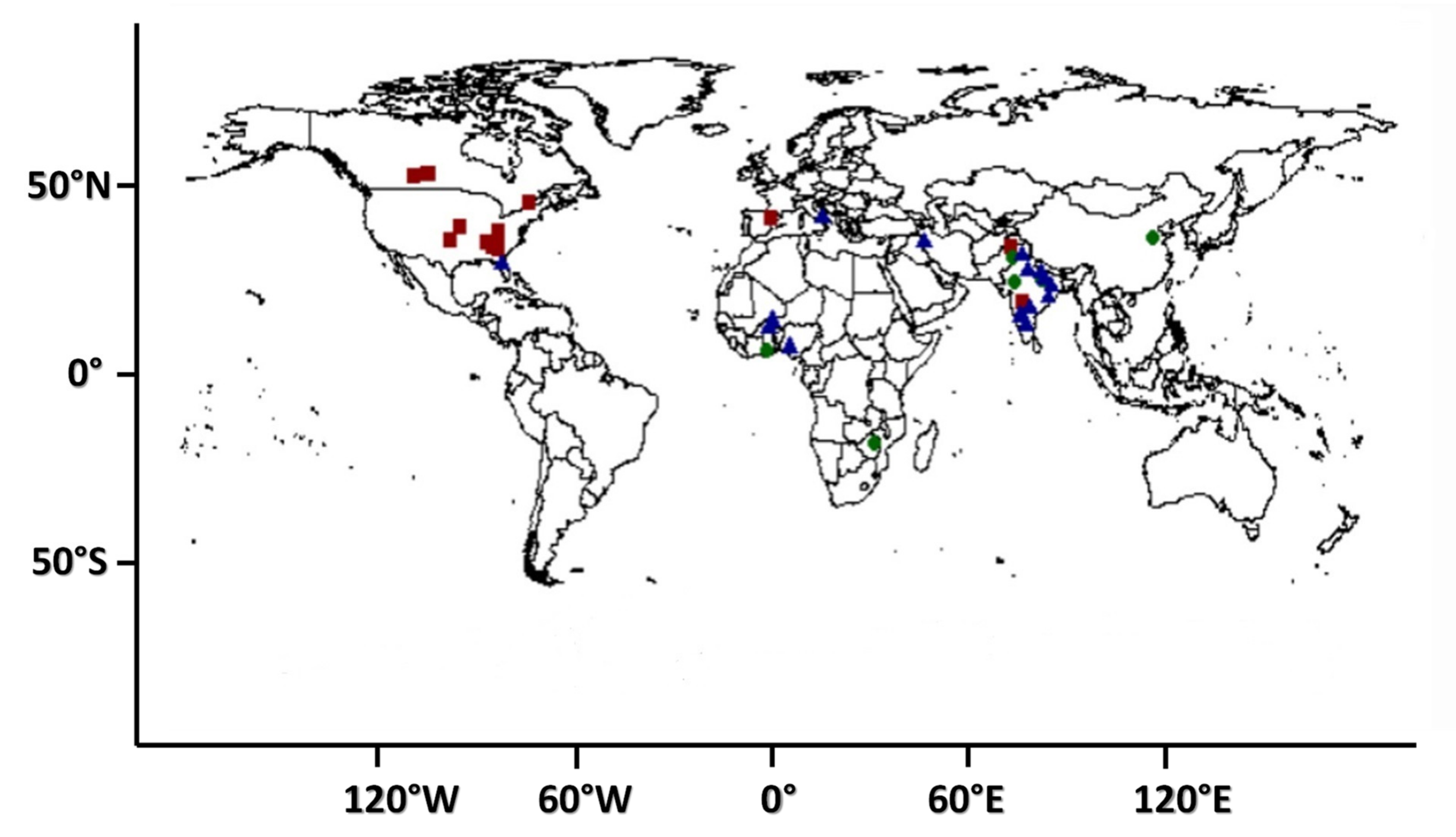
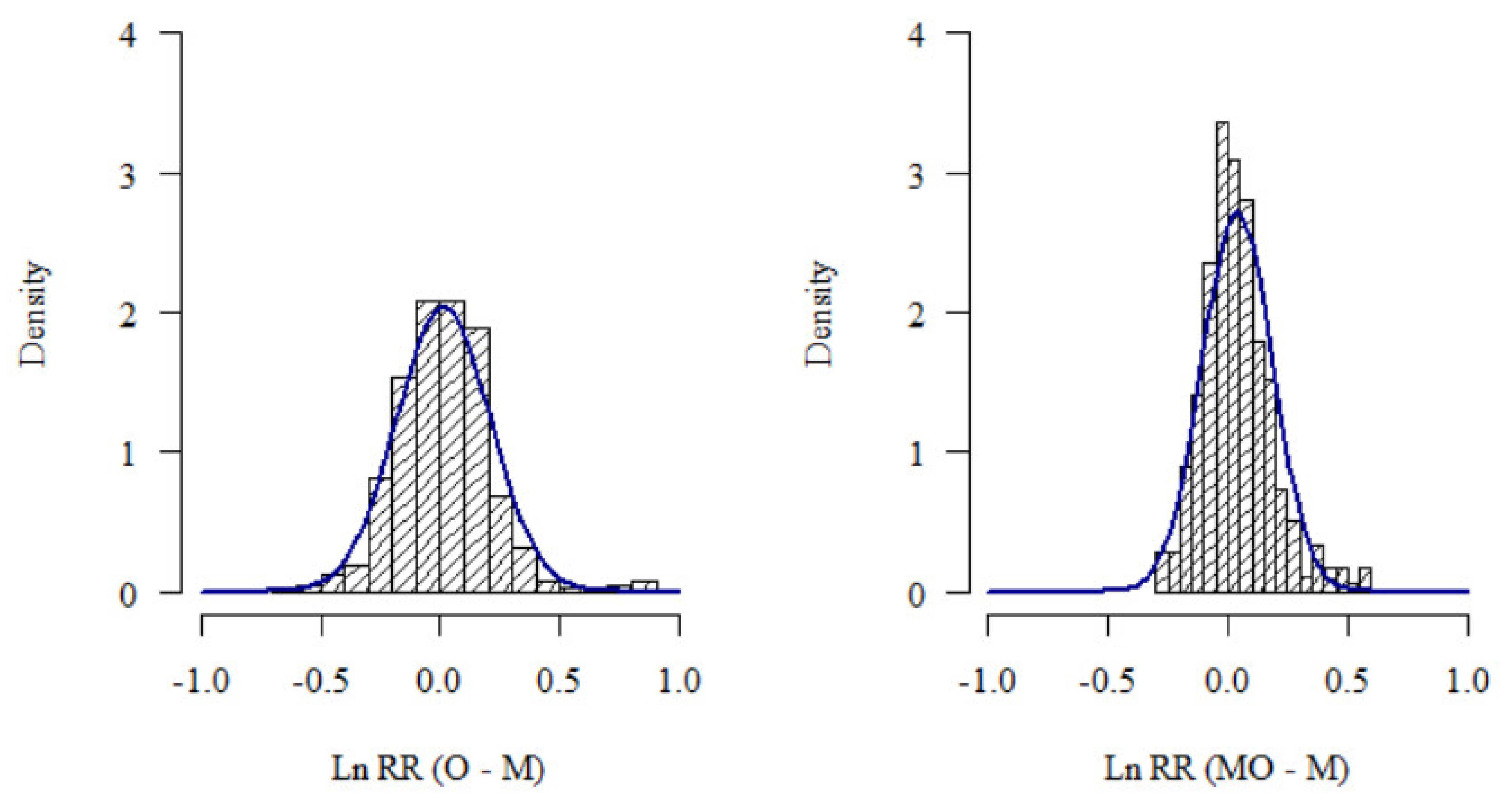
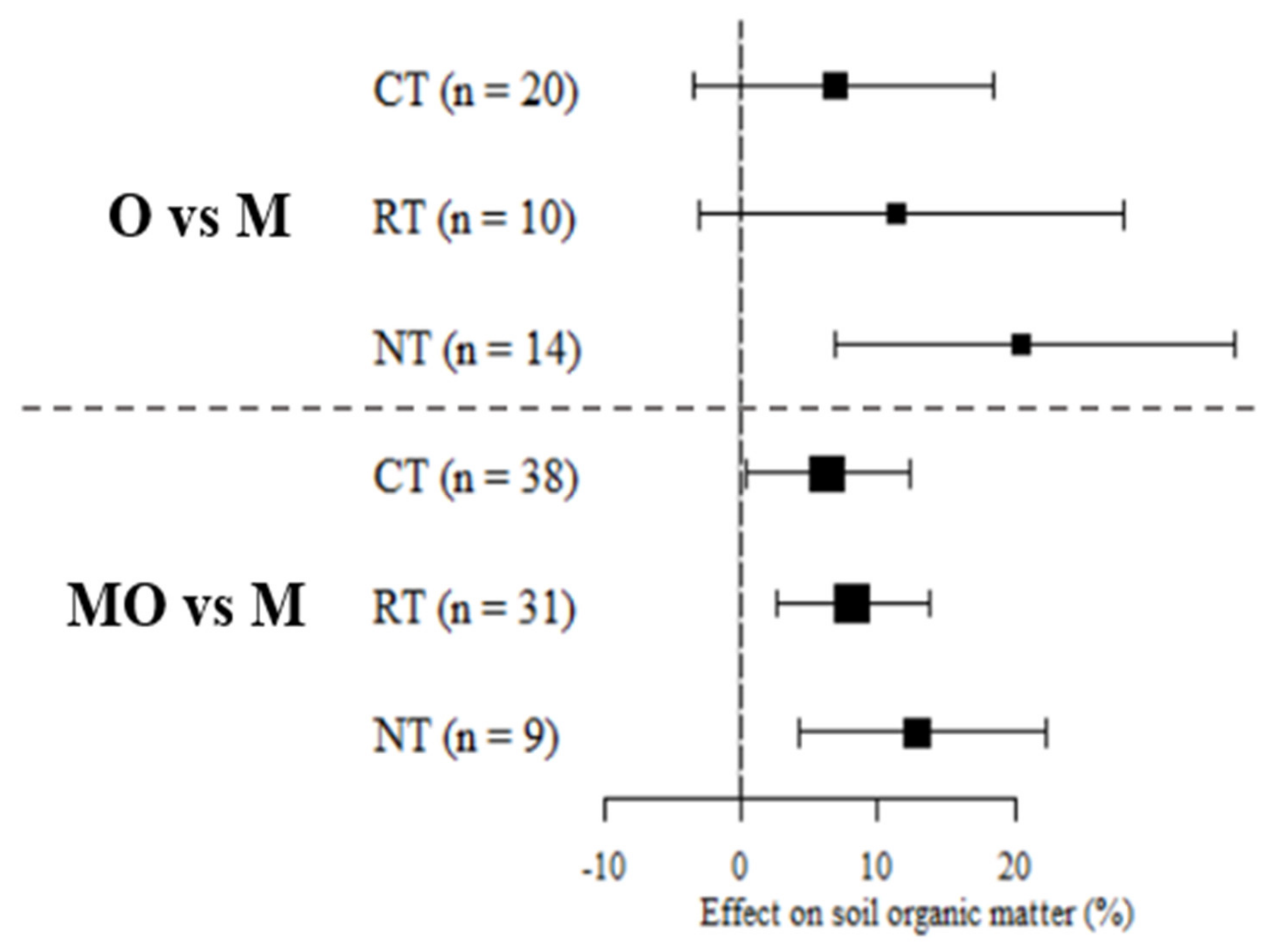
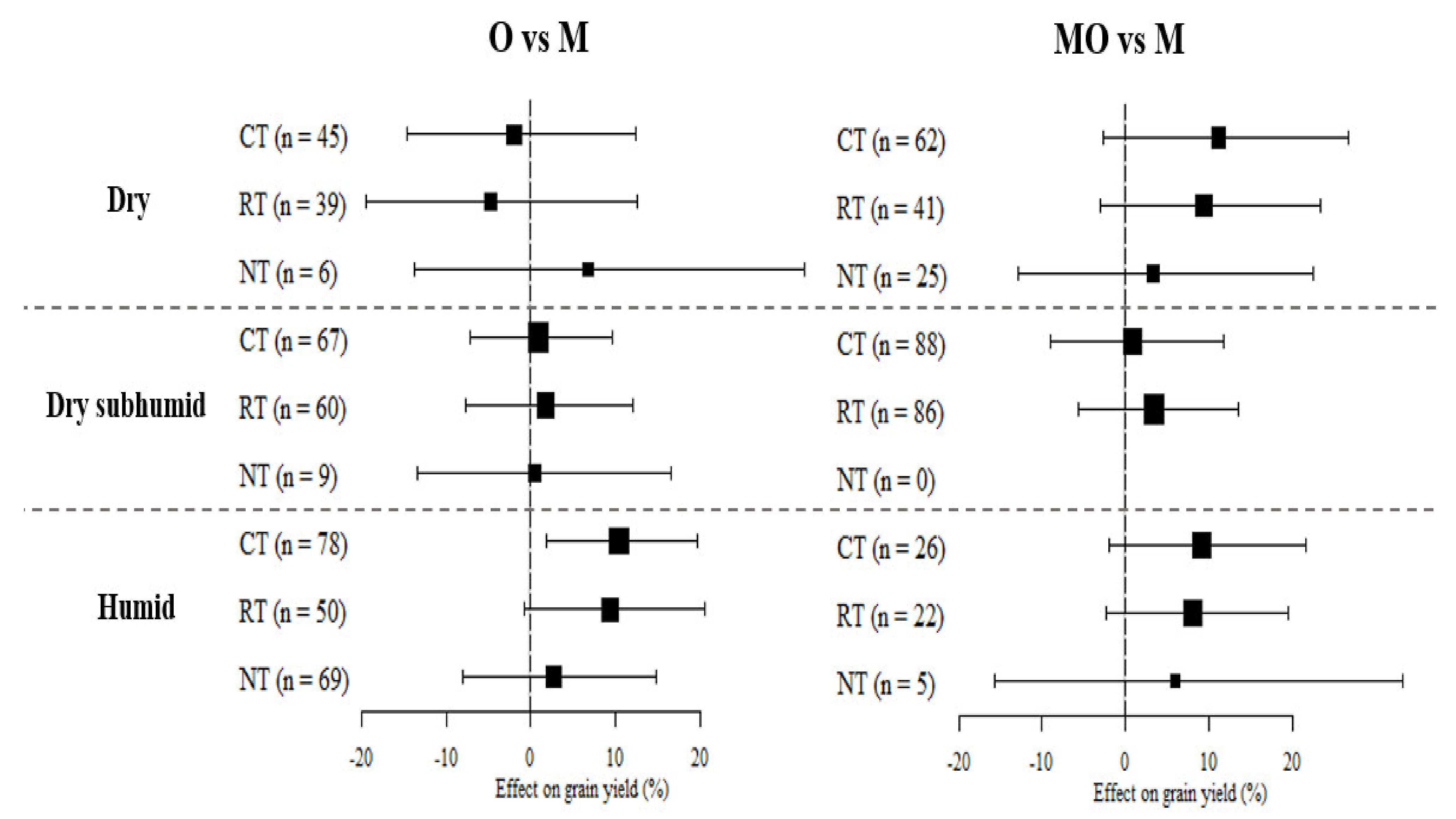
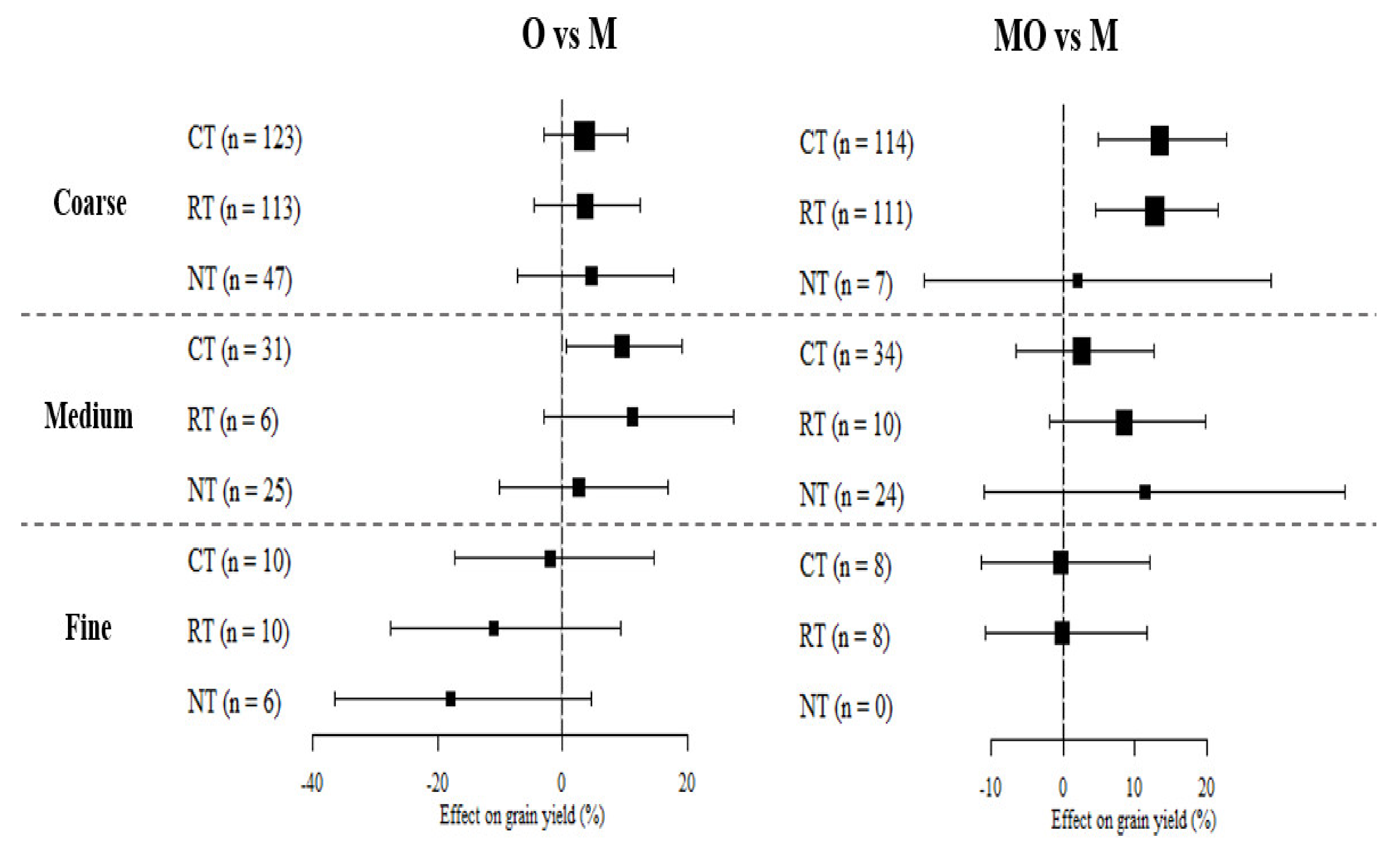
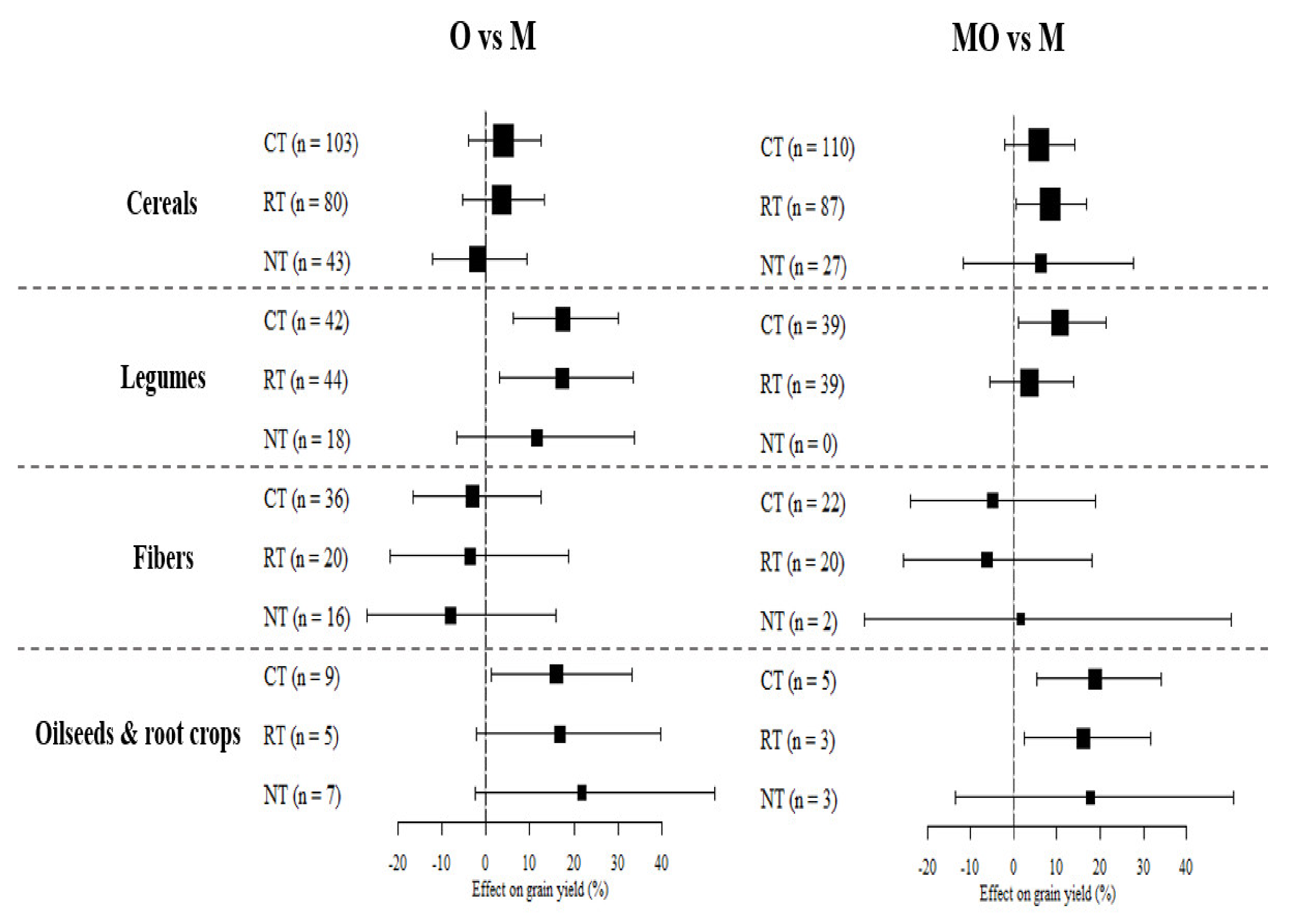
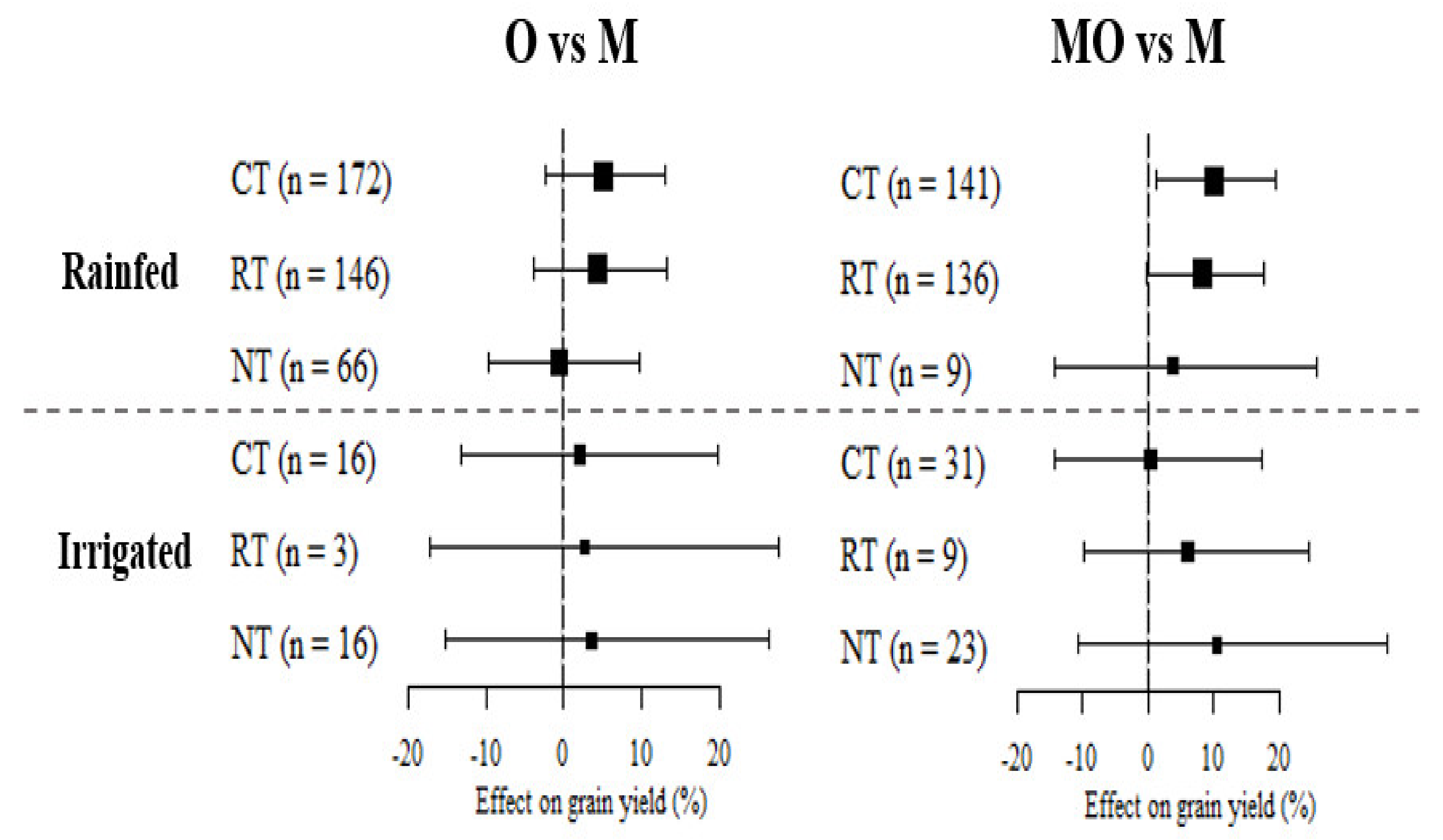
| Authors | Crop Species | Tillage System | Fert. Source | Response Variable |
|---|---|---|---|---|
| [20] Kumar et al. 2020 | Cereal | CT, RT | M, MO | Yield, SOC |
| [21] Shumba et al. 2020 | Cereal | CT, RT | M, MO | Yield, SOC |
| [22] Pradhan et al. 2020 | Cereal, Legume | CT, RT | M, O, MO | Yield |
| [23] Ramachandrappa et al. 2019 | Cereal, Legume | CT, RT | M, O, MO | Yield, SOC |
| [24] Siebou et al. 2019 | Cereal, Legume | CT, NT | M, O, MO | Yield |
| [25] Somenahally et al. 2018 | Cereal | CT, NT | M, O | Yield, SOC |
| [26] Sheoran et al. 2016 | Cereal | CT, RT | M, O, MO | Yield |
| [27] Sharma et al. 2015 | Cereal, Legume | CT, RT | M, O, MO | Yield, SOC |
| [28] Choulwar et al. 2015 | Fiber | CT, RT | M, O, MO | Yield, SOC |
| [29] Huang et al. 2015 | Cereal | CT, NT | M, MO | Yield |
| [30] Amegashie, 2014 | Cereal | CT, RT, NT | M, O, MO | Yield |
| [31] Endale et al. 2014 | Cereal | CT, NT | M, O | Yield |
| [32] Qadir Memon et al. 2014 | Cereal | CT, NT | M, O, MO | Yield |
| [33] Mohammadi et al. 2013 | Oilseed | CT, RT, NT | M, O, MO | Yield |
| [34] Patil et al. 2013 | Cereal | CT, RT | M, O, MO | Yield |
| [35] Sankar et a. 2013 | Cereal, Legume, Oilseed | CT, RT | M, O, MO | Yield |
| [36] Kumar et al. 2012 | Cereal | CT, RT, NT | M, MO | Yield |
| [37] Watts & Allen Torbert, 2011 | Cereal, Legume | CT, RT, NT | M, O | Yield, SOC |
| [38] Agbede, 2010 | Root crop | CT, NT | M, O, MO | Yield, SOC |
| [39] Montemurro, 2009 | Cereal | CT, RT | M, O, MO | Yield |
| [40] Reddy et al. 2009 | Fiber, Cereal | CT, NT | M, O | Yield |
| [41] Nema et al. 2008 | Cereal | CT, RT | M, O, MO | Yield |
| [42] Tewolde et al. 2008 | Fiber | CT, NT | M, O, MO | Yield |
| [43] Ouedraogo et al. 2007 | Cereal | CT, NT | M, O, MO | Yield, SOC |
| [44] Khan et al. 2007 | Cereal | CT, NT | M, MO | Yield, SOC |
| [45] Pendell et al. 2004 | Cereal | CT, NT | M, O | Yield |
| [46] Reddy et al. 2004 | Fiber | CT, NT | M, O | Yield |
| [47] Hook, 1999 | Fiber | CT, NT | M, O | Yield |
| [48] Eghball & Power, 1999 | Cereal | CT, NT | M, O | Yield |
| [49] Stevenson et al. 1998 | Cereal, Oilseed | CT, NT | M, O | Yield |
| [50] Blumberg et al. 1997 | Cereal | CT, NT | M, O | Yield |
| [51] Weill et al. 1989 | Cereal | CT, RT, NT | M, O | Yield |
| [52] Groffiman et al. 1987 | Cereal | CT, NT | M, O | Yield |
Publisher’s Note: MDPI stays neutral with regard to jurisdictional claims in published maps and institutional affiliations. |
© 2022 by the authors. Licensee MDPI, Basel, Switzerland. This article is an open access article distributed under the terms and conditions of the Creative Commons Attribution (CC BY) license (https://creativecommons.org/licenses/by/4.0/).
Share and Cite
Allam, M.; Radicetti, E.; Quintarelli, V.; Petroselli, V.; Marinari, S.; Mancinelli, R. Influence of Organic and Mineral Fertilizers on Soil Organic Carbon and Crop Productivity under Different Tillage Systems: A Meta-Analysis. Agriculture 2022, 12, 464. https://doi.org/10.3390/agriculture12040464
Allam M, Radicetti E, Quintarelli V, Petroselli V, Marinari S, Mancinelli R. Influence of Organic and Mineral Fertilizers on Soil Organic Carbon and Crop Productivity under Different Tillage Systems: A Meta-Analysis. Agriculture. 2022; 12(4):464. https://doi.org/10.3390/agriculture12040464
Chicago/Turabian StyleAllam, Mohamed, Emanuele Radicetti, Valentina Quintarelli, Verdiana Petroselli, Sara Marinari, and Roberto Mancinelli. 2022. "Influence of Organic and Mineral Fertilizers on Soil Organic Carbon and Crop Productivity under Different Tillage Systems: A Meta-Analysis" Agriculture 12, no. 4: 464. https://doi.org/10.3390/agriculture12040464









